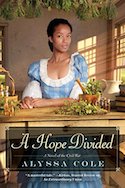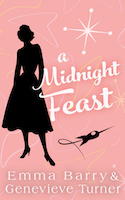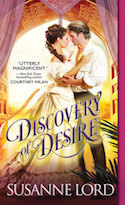Kissing Books: historically speaking
New Column! Every month, Olivia Waite pulls back the covers, revealing the very best in new, and classic, romance. We're extending a hand to you. Won't you take it?
So now comes the end of this year of years, where the days have piled up like stones, each new one adding a fresh ounce of dread to the heap. I’m always thinking about time in the winter — thanks to my favorite piece of time-travel fiction, A Christmas Carol — but 2017 has played an extra merry hell with my sense of the daily ebb and flow. So I’m peering at time with double-surly eyebrows this December.
Historical romance is the most obvious place to start talking about how romance novels engage with the concept of time, because being set in the past is their defining feature. You recognize a historical romance because shows you Then rather than Now. And it’s usually at least a hundred years in the past — despite treasured examples like the Fly Me to the Moon series and ’s excellent Tang Dynasty books and this disco romance, by far the bulk of historical romance falls in the long 19th century. There are more than a few overlapping theories about why this happened, keeps happening, and will presumably keep happening for some time to come.
For one, the obvious influence of 19th-century genre originators: Jane Austen and Jane Eyre are both still wildly popular and much imitated. People tend to overlook the fact that Jane Austen was depicting her contemporaries but Brontë set Jane Eyre thirty years in the past. Georgette Heyer came along in the early decades of the twentieth century to finish establishing the Regency romance, and by the twenty-first century the genre’s borders had been widened to encompass the Victorian era. (Possibly because of long family-based series with multiple generations? Bertrice Small and Stephanie Laurens come immediately to mind.) Romance authors often start writing to be part of a conversation — they respond to a book that moved them, or correct a book they think could or should have gone differently. So the setting, once established, gets reinforced by later writers. At some interesting point whole sections of this woven net of texts began to drift away from historical reality and became a shared imaginary world (probably around the time Heyer started inventing her own Regency slang to catch plagiarists).
The existence of this shared world means an author can choose to blithely set aside the realities of 19th-century populations (many fewer dukes, many more black and brown and queer people) and handwave matters of plumbing and dentistry and STI rates. The Regency becomes a sort of fairy tale in historical dress — what readers refer to somewhat scornfully as “wallpaper historicals” (see Eloisa James’ A Kiss at Midnight for a particularly obvious example). Let’s be clear that choosing to leave chamberpots unmentioned in 1820s London is a much more forgiveable omission than leaving black or brown folks out of 1820s London. It’s not the fault of any individual book (or duke), exactly, but the overall pattern is distressing. More understandably, there is the attractive public pomp and performance of aristocratic marriage, which is currently flooding my timeline with engagement photos and delighted anticipation for a new princess bride. Whether you’re royal and titled or merely landed gentry, aristocratic marriage is about preserving property against the passage of time: the whole point is to pass the manor house and its wealth down to your heirs, unaltered.
American-set historicals, it seems to me, especially lately, engage with the past very differently. The chronological borders here are expanding, too — edging back into Hamilton territory and forward into the hedonism of the Roaring Twenties — but most are still set during the latter half of the 1800s. Particularly around the Civil War and the colonization of the American West (origins in Laura Ingalls Wilder, Margaret Mitchell, Kathleen Woodiwiss, and, according to this persuasive essay series, Indian captivity narratives). If the majority of British-set historicals keep historical events at a polite distance, American-set historicals use the past very deliberately as a mirror turned back toward the present. (Admittedly, this is at least partly due to my own reader bias as an American.) America in the 19th century was a work in progress in a way England was not and had not been for centuries. The characters aren’t merely heading West, they’re heading here, toward the future; they are creating the towns that will become the cities where the reader presently lives. Southern romances don’t just describe the battles of the Civil War: they are still fighting it — on the one side you have the plantation romances starring white slaveowners that began with Kathleen Woodiwiss and Margaret Mitchell but continue to be published and even unnecessarily, hurtfully reissued; on the other hand you have Alyssa Cole’s Loyal League and Beverly Jenkins’ black heroes and heroines of the Underground Railroad. Are there really readers who can enjoy both equally without some gold-metal mental gymnastics? I remain skeptical.
Which is not to say the American-set historical romance does not have its own particular problems of idealization and erasure. You’ll find plenty of mentions of Native and half-Native American characters in romance over the years, but barely a handful of those have been written by Native authors. And we are currently living through a time where the failures of bootstrapism and capitalism and the wholesale plunder of natural resources are staring us all right in the face — so mining towns and lumber camps and railroad expansion have lost their luster of progress.
And of course, because romance is a multi-headed hydra, all of these generalizations have exceptions. Below I gush about the newest Alyssa Cole, which reaches far back beyond its American setting and into Stoic philosophy; I also review an India-set book with a laboring-class hero that manages to critique the capitalism of the East India Company while avoiding exotifying racist clichés and exploitation of suffering.
See you again in the brand new year. May you give this old one the send-off it deserves.
Recent Romances:

Seared by Suleikha Snyder (self-published: contemporary m/f):
For a moment you couldn’t swing a dead duke around in the romance genre without hitting a stepbrother romance. Some followed in the illustrious footsteps of Clueless, others were more Say It Isn’t So. (Remember Chris Klein?) The mini-trend has passed, as they always do, but thankfully not before Suleikha Snyder got her hands on it. Hotter and more playful than her Bollywood romances, this book walks right up to the comfort line, stops long enough to wink at you, then sashays boldly forward into WTF territory. Whether that’s fantastic or far too much is going to depend entirely on the reader. Naya and Lachlan’s parents married when she was sixteen and he was twenty-one; the youngsters had an instant connection but (importantly for this reader’s comfort) did nothing physical about it. Now a decade has passed, Lachlan’s vicious, controlling father is dead and can’t stand in their way anymore: she’s an international soap opera writer, he’s a billionaire celebrity chef, and they’re both kinky as all get-out. They do it. A lot. Improbable amounts of sex. This book has heard of realism and wants nothing to do with it — every encounter is intense, mind-melting, over-the-top, and damn near perfect. Naya is a submissive but not at all a docile one, and Lock is definitely a dom who needs bossing around every now and again. The arguments are heated. The chemistry is palpable. And the food puns are exquisite.
But his eyes were unchanged, and his mouth still fought smiles like a knockout was imminent.

A Hope Divided by Alyssa Cole (Kensington: historical m/f)
Some romances let you escape. This romance will set you free.
Ewan McCall is a Union army interrogator, currently held in a Confederate prison. Marlie Lynch is a free black woman, the unacknowledged daughter of a wealthy white slave owner, who with her white sister brings food to the prisoners (and smuggles information in and out, of course). What begins with small notes scrawled in the margins of ancient philosophy texts flowers into one of the most gorgeous epistolary romances I’ve ever read: Ewan is injured escaping from prison, and Marlie hides him in the Lynch’s attic where she makes healing tonics and salves. They are only feet apart, but the necessity of silence forces them to write to one another rather than converse. This part could have gone on for another thousand pages and I would have treasured every word.
Ewan has leaned on Stoicism to get him through an abusive childhood, but his philosophy of resisting desire is slowly, irresistibly undermined by Marlie’s brilliance and beauty. For her part, Marlie has been betrayed in large and small ways by everyone she ever trusted, and guards her heart with a fierce and furious pride. There is a whole living world inside this book; it feels less like something I read and more like something I inhabited, or devoured, or dreamed. I paused briefly in chapter two to read through Epictetus’ Enchiridion so I could fully appreciate the way the book engaged with his particular strain of Stoic thought — and this was completely the right call, because this romance looks around, rolls up its sleeves, and begins taking the whole world apart. What it means to be a good person, what it means to love someone, what you can and cannot control, how to deal with a personal and political history built on pain and loss — Ewan and Marlie set all these questions to boil, distilling them down to their essences in search of a life pointed toward truth and goodness. And love, though the word only hovers lightly over the text, letting the sheer devotion and bravery of the characters do all the heavy lifting. It is an astonishing, glorious read from which I may never recover.
She should be quiet and unassuming, given the secret she held two flights of stairs away, but apparently her rebellious side had begun to bloom, like a nightshade that unfurls when shrouded in darkness.

A Midnight Feast by Emma Barry and Genevieve Turner (self-published: historical m/f)
If you’ve read the other books in the Fly Me to the Moon series — midcentury space race historicals set in a fictionalized NASA, and they’re great — you’ll know Margie Dunsford runs everything socially for the astronaut wives. You’ll also know she and her husband Mitch have only the tattered shadows of passion left for one another. This longish novella, just shy of a full novel, stretches backward and forward in time to show us the Dunsford marriage as it rises, falls, and ultimately rises again. Marriage-in-trouble romances are hard to get right because they have to be more inwardly focused than other romance types: wondering if a partner is The One requires much less introspection than trying to decode What Went Wrong, how much blame falls to either side, and whether anything real can be salvaged. This book is a deep dive into the way two people can grow apart without realizing it, and watching Margie and Mitch as they make and unmake a lifetime’s worth of mistakes is both acutely painful and wonderfully rewarding. All this against a 1960s background of Jell-O molds, cocktails, and crinolines. It’s not the heart-smashing masterpiece that Earth Bound was, but it’s a damn fine book.
It had been like playing a part — but he knew all about that. These days he glided through life. He said the lines and did the work until he couldn’t separate the pretense from reality. Maybe that was the secret: there wasn’t any other, better reality. This was it.

Discovery of Desire by Susanne Lord (Sourcebooks: m/f historical)
The steps for reading this book are as follows. One: Oooh, what a pretty cover! Two: Is that a blurb from Courtney Milan? Three: turn to first page. Four: fall headlong in love with the giant, lumbering diamond-in-the-rough hero and the petite, managing, steely heroine. Seth Mayhew spent years hunting orchids in the jungles of Brazil: now he has come to Bombay to search for his missing sister. His translator meets him at the wharf — but Seth is not the only person he’s waiting for. Turns out the translator has gotten himself engaged to a venture girl (mail-order bride) from England, a poised and pretty problem-solver named Wilhelmina Adams. Minnie, as Seth almost immediately begins calling her, has made the journey with her sister, another venture girl whose fiancé just so happens to be a botanist on the same crew as Seth’s missing sister. There are so few coincidences in romance.
The sense of place here is phenomenal, a tropical port city so vividly rendered that you can all but feel the humid sweat on the back of your neck. The characters, too, are vivid and engaging — Seth’s easy if unpolished charm (as a younger man his sister named him the Worst Flirt in the Midlands) makes for a lovely contrast to Minnie’s formality and directness. The last third of the story returns to London for a bit more angst than was probably required, but this small flaw is more than made up for by the fact that we get a suspenseful orchid auction scene at the climax where all our hero’s hopes for love and happiness rest on one question: how much will these unbelievably rich obsessives pay for their pretty, useless plants?
All these charms aside, this book is an excellent example of how to confront the evils of racism and colonialism while still staying firmly in your lane as a white author. We don’t need a fetishizing setpiece of Brown People Suffering to show how cruel the men of the East India Company are — instead we see how much indifference they wield against our white-but-laboring-class hero and are explicitly invited to extrapolate outward to India and the whole British empire. The Company men’s sense of entitlement is palpable and terrifying, and Seth’s role as an explorer/gatherer for the company lets him reveal how deeply greedy they are as a group: “They take away everything. Anything they can take, they’ll take.” It’s a narrow view onto a vast, complex issue, but it deftly avoids many of the exotifying pitfalls we’ve grimly come to expect from so many India-set historicals. Later scenes of working poverty in London’s lower-class neighborhoods bring this book surprisingly close to a critique of capitalism.
There wasn’t a wrinkle on her skirts or a wayward crease in its folds. And that straight spine was all the sight he had of her — she didn’t fidget and she didn’t turn. Composed, capable, orderly-like. He’d drive a woman like that to Bedlam. But he fell a little bit in love with her anyway.
This Month’s Scrooge of a Heroine

A Christmas Bride by Mary Balogh (Dell: m/f historical):
Like many writers, I often imagine plot as a physical shape: an arc that rises and falls, a set of points in a constellation, a circle coming back around to its starting point. We talk of enemies-to-lovers or marriage of convenience tropes as though they are ready-made vessels waiting to be filled. As though what we pour in there — which is to say, the fluid stuff of character — does not affect the nature of that shape.
If you fill a champagne flute with hemlock, can you still call it a champagne flute?
Plot-wise, A Christmas Bride has the sweet shape of a classic Christmas Regency: Mr. Edgar Downes is a wealthy self-made man whose father is insisting he take a genteel bride before Christmas. He has his pick of docile, well-behaved prospects, but becomes entangled with a woman who is both irresistible and totally unsuitable as a marriage prospect. An unplanned pregnancy compels them to wed, emotions develop and are revealed, a happy ending arrives just when it seems least likely. It’s a shape designed to sparkle, whether you fill it with cheap cider or the most subtle and exquisite blanc de noirs. I’m an experienced reader: I came looking for sparkles. I anticipated a saucy bluestocking or blushing wallflower would prick Edgar’s ego and disturb his comfort. Hell, so do the secondary characters, fresh from their own recent and fertile romances: “The combination of a wedding an an imminent Christmas was enough, it seemed, to transport everyone to great heights of delirious joy.”
Expectation is shattered when we meet the Lady Helena Stapleton, a well-traveled widow of thirty-six. She shows up late to the ball in a red satin gown and a mocking smile, bangs our hero like a drum, and sends him home with nary a cuddle. Her attitude toward her surprise pregnancy is less secret baby and more get this facehugger off of me. She is bitter, brilliant, cynical, sharp-tongued, and, of course, emotionally scarred. Many of the reviews you’ll find mention disliking the heroine — and some of the things she’s done really are terrible. Helena is not a nice person; in fact, she’s the villain in an earlier Balogh book. She is clear-eyed enough to see the shape of the holiday romance crystallizing around her, but stubborn as she is she has to be dragged toward her happy ending under constant cursing protest. She does not want to be dragooned into happiness. She would rather be left alone.
Her presence changes the nature of her story, even though all the plot points came along in the usual order. I’d expected Edgar to be the one transformed by love and seasonal sentiment; instead, we end up with the grand battle of Hemlock Helena Versus the Redemptive Coziness of Christmas: “The great myth lifted ones spirits only to dash them afterward even lower than they had been before. She had feared it this year and sworn to resist it.” She has not been poured into the story like an afterthought — the proper metaphor here is not the champagne in the glass. The image we are looking for is chemistry: we have mixed two elements, and the mixture was beautifully volatile.